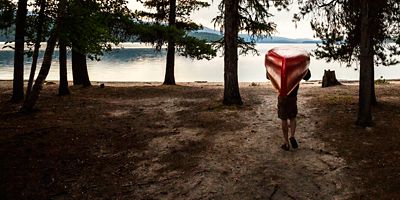Most of the year, it's easy to crave sunny days, paddling bareback under your PFD in no more than a pair of boardshorts or a bikini. But for paddlers in all but tropical climates, waiting on a small (or non-existent) weather window—when water temperatures rise enough to safely paddle without proper layers—is not an option. A wetsuit is the first option to widen that window of paddling days. Where a thick fleece and windbreaker will keep you warm in cold or breezy air, a wetsuit will ensure you don’t freeze if and when you come in contact with cold water. Keep in mind, the air doesn’t need to be frigid to wear one: A warm spring or early summer day can harbor water that’s just above the freezing mark, and certain coastal or higher-latitude destinations may never have water comfortable enough to go for a swim. So for any serious paddler, a wetsuit is an important part of the kit.
Numbers Galore: Wetsuit Thickness Explained
Wetsuits operate by a simple principle: They let cold water in, but trap it there, close to your body, which heats it. So, the more neoprene between you and the cold water, the easier it can retain that insulating layer of heat. But the warmth of thicker wetsuits, which are measured in millimeters, comes at a cost. Thicker wetsuits are obviously burlier, less flexible, heavier, and maybe even too warm in certain situations.
Manufacturers describe wetsuit thickness in a series of one, two, or three numbers. The first (and sometimes only) number is the thickness in the chest. In a two-number sequence, the second number is the thickness of both the arms and legs. And in a three-number sequence, the second is the arms, and the third is the legs. (You may need some extra insulation in your core, but not want to sacrifice maneuverability in your arms or legs.)
Keep in mind, everyone has different temperature needs—some run hot, while others need a little extra insulation—so use this chart as a rough place to start when trying to figure out how thick of a wetsuit you need:
Water Temperature (°F)
| Wetsuit Thickness
|
| 80° and higher | Rash Guard |
| 65° to 80° | 0.5 mm to 2/1 mm |
| 60° to 70° | 2 mm to 3/2 mm |
| 55° to 65° | 3/2 mm – 4/3 mm |
| 50° to 60° | 4/3 mm – 5/4/3 mm |
| 45° to 55° | 5/4 mm – 5/4/3 mm |
| 45° and lower | 6/5 mm – 6/5/4 mm |
Wet vs. Dry Suits
When it gets really cold, your body might not have enough energy to warm up the water in your wetsuit no matter how well it seals. In that case you want a suit that seals so well that you don’t get wet at all. That would be a dry suit: a full one-piece suit made of a thick waterproof-breathable material like Gore-Tex, designed to be worn over insulting base layers where water is sealed out with latex gaskets on the neck and wrists. Consider one if you plan on kayaking glacial or high-altitude creeks and rivers, icy lakes, or otherwise frigid waters where you might end up in the water. For most paddling missions when it isn’t that cold, you might be too warm and clammy in a dry suit.





